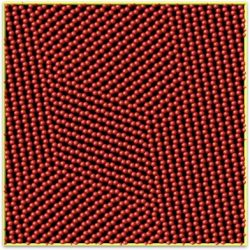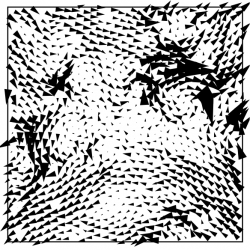In my group, we study the formation and properties of soft materials, using various numerical and analytical tools. In many cases formation and properties cannot be seen independently from each other, as many soft materials have a dynamic structure that keeps evolving even long after the material was made.
Reversibly Linked Materials

Our current focus is on polymeric materials with reversible crosslinks. Most biopolymers fall in this category, and we use the mechanisms that biological matter uses to adapt its structure as inspiration for novel synthetic “smart” materials.
Current topics include hydrogel formation, vitrimer dynamics and toughening/dissipation mechanisms of gels.
Students and postdocs involved: Nick Tito (PD), Chiara Raffaelli (PhD), Simone Ciarella (PhD), Ruben Boot (BSc).
Built-in stresses in Network Matter

From guitar strings and spider webs to edible gels, many materials owe a large part of their mechanical rigidity to the forces and stresses they are currently experiencing. Even more: the stresses they experienced while they were being formed can have a lasting effect on the mechanics even after when they are no longer present.
Current topics include states of self-stress in Mikado networks, toughening of elastomers, and tuning of mechanical properties in model network materials.
Students involved: Mathijs Vermeulen (PhD), Anwesha Bose (PhD)
New analysis techniques for Soft Matter experiments

One of my hobbies is to work with experimentalists on new techniques to analyze the wealth of experimental data that modern equipment provides. This includes extracting mechanical properties of microgel packings from the correlations in their positional fluctuations (PRL 2010), analyzing persistence lengths of supramolecular polymers (Polymer Chemistry 2016), and using calorimetry to assess mechanical properties of temperature-sensitive materials (2017 – publication under review).
Designing unusual crystal formers

Many particles form regular structures, but some structures are harder to obtain than others. We work on a relatively simple approach to make weird or unusual crystal structures, focusing on isotropic (sphere-like) particles.
Electrostatic interactions in Soft Matter

Soft Materials often live in watery environments where pH and salt concentration are crucial to their behavior. This is due to the presence of electrostatic charges in the molecules that make up the materials. We study how such effects influence the composition and structure of lipid membranes and/or the cytoskeleton, and how they affect interactions between membranes and proteins.
Jamming

Packings of soft frictionless spheres are a widely used model for emulsions and even granulates. Their study has taken a life of its own because the structures that these spheres make when you press them together ever so gently are mechanically very peculiar. They are very weird solids which resist compression much more than they resist shear, which only behave elastically on very large length scales. It is safe to say that their study introduces many physicists to concepts in rigidity theory and structural mechanics that were before only well-known to mathematicians and engineers, and this has led to many interesting new directions of research.
